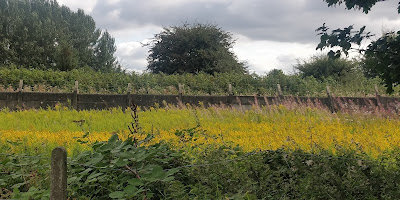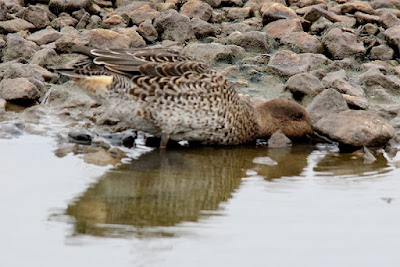 |
| Wheatear, Hole Bottom |
An early start to the day, occasioned by next door's builder getting the heavy power tools to work first thing. I decided to get away by having a walk up Winter Hill. The bright, sunny morning of eight o'clock became grey and gloomy by nine, which bode well for a comfortable walk on the moors.
I started off from Georges Lane, hopping off the 125 from Bolton. It was a quiet morning with just a few magpies and woodpigeons in the fields. A lone house martin flew over as I approached Wilderswood. I thought there were a few more over Wilderswood itself but it turned out to be 150 or more sand martins.
 |
| Walking up to Winter Hill |
I turned off onto the path that goes up to the maintenance road for the Winter Hill transmitter. The only birds along this stretch were a couple of meadow pipits. I'd walked up the road as far as Hole Bottom when I noticed a wheatear flitting about on a bit of old wall. As I was watching it I noticed a couple of others further along.
 |
| Winter Hill, looking towards Manchester |
That was the lot until I was almost at the transmitter station when a couple of red grouse shot up from the roadside and magically disappeared into the short grass not ten yards away.
 |
| Wheatear, Winter Hill summit |
There had been reports of black redstarts around here so I had a close nosy round, with nothing for my efforts save a couple more wheatears. A circling figure on the horizon turned out to be somebody's model plane.
I weighed up the options: I could carry on down to Belmont or I could turn back and wander towards Burnt Edge. The biting North wind had some wet about it, which didn't make the trek over to Belmont for a bus that runs every two hours very appealing.
So I retraced my steps and bumped into a chap who told me he'd just seen a couple of black redstarts at the edge of the transmitter compound. Typical of black redstarts to select the only bit of industrial brickwork in miles of open country. I selected a block of concrete to sit on and have my lunch (a peanut bar and a Capri-Sun) while I kept an eye out for any small bird movements. Most of the small bird movements turned out to be ends of duct tape and similar fluttering in the wind. A male pied wagtail bobbed his head out of a gutter outflow. He emerged and watched me awhile then retreated whence he came. After quarter of an hour I was starting to be glad I'd put my heavy jacket on.
I decided to move on, whereupon a small bird flitted across the compound and landed on one of the windowsills. A female or first-Winter black redstart which flicked and fanned its dark red tail then promptly disappeared. A second bird flitted over and lingered even less.
Taking one last look around the place I thought I spotted the model plane flying about again. Luckily I looked twice: it was a kestrel.
 |
| Rivington Pike from Winter Hill |
I walked back down and took the path that goes from Hole Bottom to Burnt Edge. The walk and the scenery made up for a lack of birds. A few carrion crows and meadow pipits flew about in the heather while half a dozen swallows flew overhead. Closer to Burnt Edge there were a few woodpigeons and a couple of house martins.
 |
| Walking towards Burnt Edge |
I had a rummage round the small conifer plantation on Burnt Edge and found nothing but a couple of uncharacteristically quiet wrens and a shy robin.
There were more swallows overhead on the way down to Walkers Fold. There was a lot of timber cutting going on in Walkers Fold Woods and that drowned out nearly all the bird calls.
I stopped for a few minutes in Walkers Fold car park to look at the map. Along the way I'd bumped into a chap who said a black-necked grebe was showing well on High Rid Reservoir. I reckoned the walk down was doable so I set off down Walkers Fold Road. Which turned out to be still closed for roadworks so I headed off on the footpath along Dakin's Brook to try and get round them.
A couple of ravens circled overhead, one of them holding some indeterminate object which must have been food of some sort given the other's attentions.
 |
| Sheep's bit scabious |
The path through to High Shire Clough ran through a meadow seething with sheep's bit scabious. Even on a dull day like this they attracted lots of bees, hoverflies and large white butterflies.
 |
| Dean Brook |
The woodland by Dean Brook was very quiet. I got to Barrow Bridge Road and decided not to dogleg back past the golf course to get back onto Chorley Old Road. Frankly, I didn't fancy the steep inclined plane up to the golf course. I walked into Barrow Bridge in time to just miss the bus into Bolton so walked down into Smithills and caught a bus there. I'll have to hope the black-necked grebe lingers awhile.














































